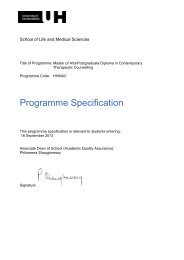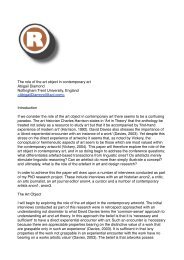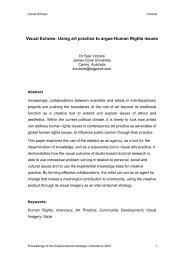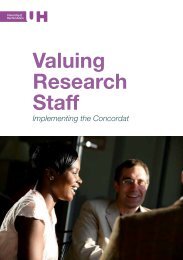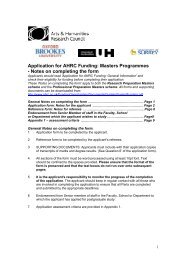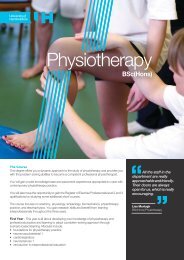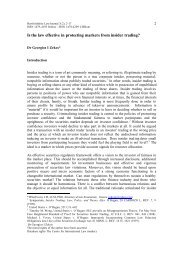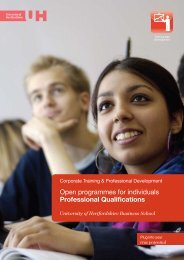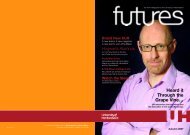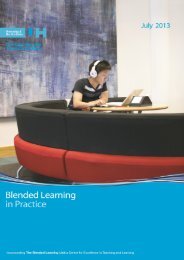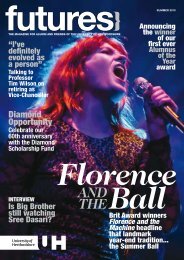Materializing pedagogies Dr Barbara Bolt University of Melbourne ...
Materializing pedagogies Dr Barbara Bolt University of Melbourne ...
Materializing pedagogies Dr Barbara Bolt University of Melbourne ...
Create successful ePaper yourself
Turn your PDF publications into a flip-book with our unique Google optimized e-Paper software.
<strong>Materializing</strong> <strong>pedagogies</strong><strong>Dr</strong> <strong>Barbara</strong> <strong>Bolt</strong><strong>University</strong> <strong>of</strong> <strong>Melbourne</strong>, AUTheorising out <strong>of</strong> practice, I would argue, involves a very different way <strong>of</strong> thinking thanapplying theory to practice. It <strong>of</strong>fers a very specific way <strong>of</strong> understanding the world, onethat is grounded in (to borrow Paul Carter's term) “material thinking” rather than merelyconceptual thinking. Material thinking <strong>of</strong>fers us a way <strong>of</strong> considering the relations that takeplace within the very process or tissue <strong>of</strong> making. In this conception the materials are notjust passive objects to be used instrumentally by the artist, but rather the materials andprocesses <strong>of</strong> production have their own intelligence that come into play in interaction withthe artist's creative intelligence. For Paul Carter, this collaboration 'is not simply apragmatic response to increasingly complex working conditions; it is what begins tohappen wherever artists talk about what they are doing, in that simple but enigmatic step,joining hand, eye and mind in a process <strong>of</strong> material thinking' (Carter, 2004: xiii) (myemphasis). I would agree with Carter that it is in the joining <strong>of</strong> hand, eye and mind thatmaterial thinking occurs, but it is necessarily in relation to the materials and processes <strong>of</strong>practice, rather than through the “talk”, that we can understand the nature <strong>of</strong> materialthinking. Words may allow us to articulate and communicate the realizations that happenthrough material thinking, but as a mode <strong>of</strong> thought, material thinking involves a particularresponsiveness to or conjunction with the intelligence <strong>of</strong> materials and processes inpractice. Material thinking is the magic <strong>of</strong> handling.If creative arts “research” commences in our dealings with the tools and materials <strong>of</strong>production, rather than a self-conscious attempt at theorization, how do we begin the task<strong>of</strong> developing creative arts research <strong>pedagogies</strong> from the bottom up, rather than from thetop down? The challenge facing us as art educators is both simple and complex: Howdoes one devise a pedagogical strategy that makes “practical sense”, but does not merelyfall back into a skills based pedagogy? This question has become particularly critical at atime when art education has become so driven by conceptual and thematic concerns thatmaterials and processes are conceived instrumentally to be used in the service <strong>of</strong> an idea,rather than as productive in their own right. In this paper I investigate how MartinHeidegger's conceptions <strong>of</strong> “handling” and “handlability” <strong>of</strong>fer an alternative pedagogy tothe conceptually driven pedagogy that currently dominates art school's curriculum.
In order to set the scene, I propose to demonstrate how David Hockney's “hands on”investigations into the drawing practices <strong>of</strong> artists from the 1400's to the 1900's enabledhim to develop a unique in-sight into the use <strong>of</strong> optical devices in the drawing <strong>of</strong> what hecalls the “Old Masters”. David Hockney begins his treatise Secret Knowledge:Rediscovering the Lost Techniques <strong>of</strong> the Old Masters (2001) by recalling a viewingexperience that pitted his own experience as a drawer with his long held assumptionsabout the drawing skills and capabilities <strong>of</strong> “The Old Masters”:When I went to see the Ingres exhibition at the National Gallery in London in January1999, I was captivated by his very beautiful portrait drawings—uncannily 'accurate' aboutthe features, yet drawn at what seemed to me to be an unnaturally small scale…. Over theyears I have drawn many portraits and I know how much time it takes to draw the wayIngres did. I was awestruck. 'How had he done them?' I asked myself. (Hockney, 2001: 21)On first appearance this seems like a straight forward art historical enquiry. HoweverHockney makes a very critical point, pertinent to the notion <strong>of</strong> practice-led research, whenhe suggests that such observations and such questioning could only have been made 'byan artist, a mark-maker, who is not as far from practice, or from science, as an arthistorian” (Hockney, 2001:13). Here Hockney sets up a division that is not entirely valid,since many art historians are also practitioners, but his point is a critical one. It is thespecial kind <strong>of</strong> “sight” that Hockney gained through being a practitioner that enabled him tobe able to <strong>of</strong>fer both original and originary approaches and insights into the drawings <strong>of</strong>Ingres. The specificity <strong>of</strong> Hockney's experience as an artist, and particularly a drawer,fashioned the nature <strong>of</strong> the question, the methodology and the types <strong>of</strong> realisations thatemerged from the investigation.Hockney's research question was a very simple one. How had Ingres achieved suchuncannily accurate portraits at such a small scale in such a limited time frame? From hisown experience as a drawer it did not seem possible that Ingres could have achieved theaccuracy, demonstrated in these drawings, through direct observation and free handdrawing. In setting out his enquiry, Hockney followed his hunch that Ingres had in fact useda camera obscura to make these drawings. In order to test this proposition, he set aboutmaking drawings using a camera lucida and compared them with drawings that had beenachieved through what he terms “eyeballing” or unaided freehand drawing. Through thesedrawing experiments he observed that not only could the use <strong>of</strong> this optical device achieveuncanny accuracy, but more importantly drawings made this way were characterised by aparticular quality <strong>of</strong> drawn line that distinguished them from freehand drawing. The linewas much surer and more confident than the “groping lines” <strong>of</strong> a drawer struggling to “see”and record freehand. However, in this confidence the drawn line lacked the struggle, thevariation in line quality and indeterminacy <strong>of</strong> the eyeballed drawing.In this investigation, Hockney's research methodology was idiosyncratic and whilst hisresearch findings have been the subject <strong>of</strong> much debate, it is precisely this idiosyncraticmethodology that highlights the importance and relevance “handling” and “materialthinking”. Firstly, the initial question that drove Hockney's research arose out <strong>of</strong> adisjunction between his understanding <strong>of</strong> the possibilities <strong>of</strong> drawing and the disbelief heexperienced when viewing Ingres' (1829) drawing <strong>of</strong> Madam Godinot. Secondly,Hockney's hunch and subsequent visual hypothesis about Ingres' drawings derived fromhis experience in using projection devices and photographic technology in his work.Thirdly, his experience as a drawer predicated the particular methodology he developed totest his observations in the laboratory <strong>of</strong> drawing. Fourthly, Hockney focussed onparticularity, rather than a generalization to examine his proposition. Finally, and most
importantly, Hockney's visual argument demonstrates the double articulation betweentheory and practice, whereby theory emerges from a reflexive practice at the same timethat practice is informed by theory. His thesis demonstrates the material nature <strong>of</strong> visualthinking.Hockney's insights demonstrate a very specific sort <strong>of</strong> knowing, a knowing that arisesthrough handling materials in practice. This form <strong>of</strong> tacit knowledge provides a veryspecific way <strong>of</strong> understanding the world, one that is grounded in material practice or“material thinking” rather than in conceptual thinking. Material thinking is the logic <strong>of</strong>practice.Hockney's observations about Ingres' drawings arose out <strong>of</strong> a sustained and sustainingdrawing practice. His particular tacit knowledge came from the experience <strong>of</strong> working withpencils, charcoals, paint, projections and the camera in realizing an image—and inparticular in the struggle to render reality “out there” on a two dimensional surface with agraphite pencil. Put simply, his engagement with the tools and technologies <strong>of</strong> drawingpractice produced its own kind <strong>of</strong> sight or logic.Martin Heidegger terms the kind <strong>of</strong> “sight”, through which we come to know how to draw,to paint, to dance or to write, circumspection. For Heidegger, it is through circumspectionthat that the “new” emerges. In this way artists gain access to the world, in whatEmmanuel Levinas terms, an 'original and an originary way' (Levinas, 1996: 19). Originaryis a term rarely used, but one that seems particularly pertinent to creative arts research. Itis a way <strong>of</strong> understanding that derives from, or originates in and <strong>of</strong> the thing in question. Inthis case, the “thing” in question is practice. It is understanding that originates in andthrough practice.In Being and Time (1966) Martin Heidegger sets out to examine the particular form <strong>of</strong>knowledge that arises from our handling <strong>of</strong> materials and processes. Heidegger arguesthat we do not come to “know” the world theoretically through contemplative knowledge inthe first instance. Rather, we come to know the world theoretically only after we have cometo understand it through handling. Thus the new can be seen to emerge in the involvementwith materials, methods, tools and ideas <strong>of</strong> practice. It is not just the representation <strong>of</strong> analready formed idea or is it achieved through conscious attempts to be original.Heidegger's notion <strong>of</strong> handlability is orientated around a constellation <strong>of</strong> praxical terms. Hesuggests that the primary relationships we have with the world are those things that wedeal with, noting that the kind <strong>of</strong> dealing which is closest to us … is not bare perceptualcognition, but rather that kind <strong>of</strong> concern which manipulates things and puts them touse…. Such entities are not thereby objects for knowing the 'world' theoretically(Heidegger, 1962: 95). Thus for Heidegger it is only through use that we gain access to theworld. Heidegger makes this distinction between theoretical conception and praxicalunderstanding clear when he argues that it is through active use, we establish originalrelations with things. He cites the example <strong>of</strong> the using a hammer to support hiscontention:The less we just stare at the thing called hammer, the more actively we use it, the moreoriginal our relation to it becomes and the more undisguisedly it is encountered as what itis, as a useful thing. The act <strong>of</strong> hammering itself discovers the specific “handiness” <strong>of</strong> thehammer…. No matter how keenly we just look at the “outward appearance” <strong>of</strong> thingsconstituted in one way or another, we cannot discover handiness. When we just look atthings “theoretically,” we lack an understanding <strong>of</strong> handiness. But association which makes
use <strong>of</strong> things is not blind, it has its own way <strong>of</strong> seeing which guides our operations andgives them their specific thingly quality. (Heidegger, 1996: 65)The kind <strong>of</strong> being that a tool or material possesses comes to light in the context <strong>of</strong>handlability. I can look at pots <strong>of</strong> different coloured paints, a camera or a computer screenand take pleasure in contemplating them, but it is only in use that they begin to reveal theirpotential. I can lay out my brushes and set a fresh canvas before me, but until I actuallybegin to work with them in making a painting I can not understand their being. Similarly Imay think I have a good idea, but until I begin to work with it and “handle” it I can notunderstand where it will take me.Thus Hockney did not understand the making <strong>of</strong> Ingres' drawing theoretically throughcontemplative knowledge in the first place. Rather, he came to understand the nature <strong>of</strong>Ingres' drawing through the “sight” that his own drawing practice opened up. Through suchhandlings, his apprehension was neither merely perceptual nor rational. Handling ormaterial thinking revealed its own kind <strong>of</strong> tacit knowledge, a knowledge that can begeneralized beyond an individual artist's practice to enter into the discursive dialogue withother discourses, such as those <strong>of</strong> art history, art theory and drawing. Hockney did not setout to find the new, but the new arrived to confront him. I would suggest that the “shock <strong>of</strong>the new” is thus a particular understanding that is realized through our dealings with thetools and materials <strong>of</strong> production, and in our handling <strong>of</strong> ideas, rather than a selfconsciousattempt at transgression. This is material thinking.If we are to begin with Heidegger's premise that we come to know the world theoreticallyonly after we have come to understand it through handling, how do we structure programsto give “voice” to material thinking? At first glance, it may appear that this <strong>of</strong>fers a return tothe skills based pedagogy that preceded the conceptual turn. Such pedagogy tends toemphasise a relation <strong>of</strong> mastery in the use <strong>of</strong> materials and processes by the artist.Materials and processes are used by the artist to produce an artwork. HoweverHeiddeger's insights do not support such a return. Whilst in Being and Time (1929) heuses the terms “handiness” and “use value” to set out his tool analysis, (terms that suggestan instrumentalist use <strong>of</strong> tools to achieve an end, for example, an artwork), his later essay,'The question concerning technology' (1954) <strong>of</strong>fers a reconceptualisation <strong>of</strong> what handlingmight involve.In 'The question concerning technology', Heidegger questions the contemporaryinstrumentalist understanding <strong>of</strong> the human-tool relationship—using tools and materials asa means to an end—in order recast our understanding <strong>of</strong> the relations between humans,and technology. In a challenge to the contemporary figuring <strong>of</strong> our relations with tools andprocesses as one <strong>of</strong> mastery, he posits a relationship <strong>of</strong> co-responsibility andindebtedness. In this reconfiguration, handling is no longer predicated on the use value <strong>of</strong>technology, but rather our “technologies” become co-collaborators in the revealing <strong>of</strong>Being.The radicality <strong>of</strong> Heidegger's refiguration <strong>of</strong> the human-tool relation has tended to beoverlooked, particularly in the creative arts. I would suggest that the shift from theinstrumentalist use <strong>of</strong> materials towards a notion <strong>of</strong> handlability and concernful dealings,provides the context to develop creative arts <strong>pedagogies</strong> around material thinking. Firstly it<strong>of</strong>fers another sight into how knowledge emerges from practice. Secondly it <strong>of</strong>fers adifferent way <strong>of</strong> thinking about our relations with our tools, a way <strong>of</strong> thinking that I wouldargue ushers in a post human “understanding” <strong>of</strong> creative practice.
When Heidegger talks <strong>of</strong> understanding, he is not referring to understanding as a cognitivefaculty that is imposed on existence. For him, understanding is the care that comes fromhandling, <strong>of</strong> being thrown into the world and dealing with things. Emmanuel Levinas notesthat the originality <strong>of</strong> Heidegger's conception <strong>of</strong> existence lies in positing a relation that isnot centred on the self-conscious subject. He says 'in contrast to the traditional idea <strong>of</strong>“self-consciousness” [conscience interne], this self-knowledge, this inner illumination, thisunderstanding … refuses the subject/object structure' (Levinas, 1996: 23). This relation <strong>of</strong>care is not the relation <strong>of</strong> a knowing subject and an object known. Rather what is critical toHeidegger's notion <strong>of</strong> understanding is that it emerges through the care <strong>of</strong> handling. In thisway, handling as care comes to supplant the instrumentalist in-order-to that defines thecontemporary engagement <strong>of</strong> humans with technology and also with the world.What then makes art a special case <strong>of</strong> handling? Surely everyday life is concerned withhandling, whether it is with tools, emotions, ideas or other beings. We understand, forexample, that children learn to ride a bike by riding it, not by being told how to ride it andthat the instructions that come with flat packs are no substitute for the trial and error that ittakes to put something together. How is art any different? Heidegger suggests that in theeveryday, our handling <strong>of</strong> things tends to become habitual. When we become habituatedwe forget the wonder <strong>of</strong> it all. Our handlings become a means to an end. The privilegedplace <strong>of</strong> art arises from its capacity to create an opening, a space in which we are forcedto reconsider the relations that occur in the process or tissue <strong>of</strong> making life. It is here thatwe can contest the instrumentalism <strong>of</strong> contemporary ways <strong>of</strong> being.Heidegger's critique <strong>of</strong> instrumentality derives from his questioning <strong>of</strong> the essence <strong>of</strong>causality. He argues that the essence <strong>of</strong> causality is not, as modern thought would have it,a simple case <strong>of</strong> cause and effect. He suggests that for the Greeks, causality is 'the letting<strong>of</strong> what is not yet present arrive into presencing' (Heidegger, 1977: 10). Through a carefulunpacking <strong>of</strong> the etymology <strong>of</strong> the term causa, Heidegger traces the origin <strong>of</strong> the termback to the Greeks. Whilst causa was the Roman designation for cause, the Greeks usedthe term aition. In Greek thinking, aition carries with it a different sense. Here, according toHeiddegger, aition means 'that to which something else was indebted' (Heidegger, 1977:7).The relevance <strong>of</strong> this rethinking <strong>of</strong> “causality”, for creative arts pedagogy, is set out byHeidegger in the example <strong>of</strong> the making <strong>of</strong> a silver chalice. Here Heidegger teases out adifferent and complex relationality between the silversmith, the silver and the idea <strong>of</strong> achalice and the chalice, to exemplify how the making <strong>of</strong> a silver chalice involves relations<strong>of</strong> indebtedness and co-responsibility. His argument unfolds as follows:Silver is that out <strong>of</strong> which the silver chalice is made. As this matter (hyle), it is coresponsiblefor the chalice. The chalice is indebted to, that is, owes thanks to, the silverout <strong>of</strong> which it consists. But the sacrificial vessel is indebted not only to the silver. As achalice, that which is indebted to the silver appears in the aspect <strong>of</strong> a chalice and not inthat <strong>of</strong> a brooch or a ring. Thus the sacrificial vessel is at the same time indebted to theaspect (eidos) or idea <strong>of</strong> chaliceness. Both the silver into which the aspect is admitted aschalice and the aspect in which the silver appears are in their respective ways coresponsiblefor the sacrificial vessel…. But there remains yet a third that is above allresponsible for the sacrificial vessel. It is that which in advance confines the chalice withinthe realm <strong>of</strong> consecration and bestowal…. Finally there is a fourth participant in theresponsibility for the finished sacrificial vessel's lying before us ready for use, i.e., thesilversmith. (Heidegger, 1977: 8)
Thus where we have come to accept the view that humans use materials and methods toachieve an artistic end, Heidegger makes the claim that the four ways <strong>of</strong> being responsiblelet something come to into appearance. Thus in this reversal <strong>of</strong> the causal chain <strong>of</strong> meansand ends we can reconfigure the “artistic relation”: artists, objects, materials andprocesses become co-responsible for the emergence <strong>of</strong> art.Whilst Heidegger “uses” the silversmith example as an illustration for his philosophicalideas, his argument makes practical sense to a maker. In watercolour painting, forexample, one becomes very aware <strong>of</strong> the complex set <strong>of</strong> inter-relations that allow awatercolour to emerge.In the relation <strong>of</strong> care that characterises artistic production, the artist is no longerconsidered the sole creator or “master” <strong>of</strong> the painting. On the contrary, the artist is coresponsiblefor allowing art to emerge. In the constellation, the matter <strong>of</strong> paint, paper andthe materials and technologies <strong>of</strong> production—watercolours, brushes, sponges, water,paper, gravity, humidity—are not a means to an end; the motif or the idea is no longerconceived as an object for a human subject; nor is the artwork merely an end. Handling ascare produces a crucial moment <strong>of</strong> understanding or circumspection. This “materialthinking” not the completed artwork, is the work <strong>of</strong> art.The relationship <strong>of</strong> care and concernful dealings signals a different way <strong>of</strong> thinking theprecise state <strong>of</strong> the interminglings between humans and technology. In our contemporaryepoch, ecological necessity has re-awakened a concern to establish a different relation tothe technological. Heidegger's critique <strong>of</strong> technological thinking and his ability to rethinkthe human relation to technology <strong>of</strong>fers us a way to differently configure the relationsinvolved in art. We can begin to talk <strong>of</strong> “skill with” rather than “mastery over” technologies,materials and processes.It remains to ground this discussion in current teaching pedagogy. I have asserted thatHeidegger's elaboration <strong>of</strong> handlability, provides a key to rethinking the conditions <strong>of</strong>possibility <strong>of</strong> creative arts pedagogy. I have suggested that understanding, with the “handsand eyes”, operates in a different register than the assumed theoretical-cognitiveengagement that characterizes contemporary art education. It <strong>of</strong>fers an alternativepedagogy to the conceptually and contextually driven pedagogy that currently dominatesart education. However in placing an emphasis on the “sight” that is gained throughhandling, Heidegger does not return us to the skills and techniques based programs thatpreceded the so-called conceptual turn, nor does it re-invoke the purity <strong>of</strong> formalism. Hisemphasis on careful and concernful dealings suggests an alternative ethic to mastery anda different engagement from our instrumentalist dealings tools and materials. It suggeststhat humans are indebted to and co-responsible for the emergence <strong>of</strong> art. I would suggestthat this refiguration <strong>of</strong> the human-technology relation sets out principles for a post-humanpedagogy. In a digital present this task appears particularly urgent.Bibliography<strong>Bolt</strong>, B. 2004 Art Beyond Representation: The Performative Power <strong>of</strong> the Image. London:I.B.Tauris.<strong>Bolt</strong>, B. 2004 'The exegesis and the shock <strong>of</strong> the new', (Text Special Issue Website Series)3, [On-line] Available:
http://www.griffith.edu.au/school/art/text/speciss/issue3/content.htm, accessed May 29,2006.Carter, P. 2004 Material Thinking: The Theory and Practice <strong>of</strong> Creative Research,<strong>Melbourne</strong>. Vic: <strong>Melbourne</strong> <strong>University</strong> Press.Freitas, N. 2004 'Towards a definition <strong>of</strong> studio documentation: working tool transparentrecord', Working Papers in Art and Design 2, http://sitem.herts.ac.uk/artdes_research/papers/wpades/vol2/freitasfull.html, Accessed May 29, 2006Gray, C. and Marlins, J. 2004 Visualizing Research—A Guide to the Research Process inArt and Design, London. Ashgate.Heidegger, M. 1977 Basic Writings, D. Farrell Krell (ed.), San Francisco: Harper and Row.Heidegger, M. 1996 Being and Time, trans. J. Stambaugh, Albany: State <strong>University</strong> <strong>of</strong> NewYork Press.Hockney, D. 2001 Secret Knowledge: Rediscovering the Lost Techniques <strong>of</strong> the OldMasters. London: Thames and Hudson.Ihde, D. 1979 Technics and Praxis, Dordrecht: Reidel.Judovitz, D. 1988 'Representation and its limits in Descartes', H.J. Silverman and D.Welton (Eds) Postmodernism and Continental Philosophy, Albany: State <strong>University</strong> Press<strong>of</strong> New York, 68-84.Levinas, E. (1996). Martin Heidegger and Ontology, Diacritics, 26: 1, 11-32.Sullivan, G. 2005 Art Practice as Research: Inquiry in the Visual Arts, Thousand Oaks,Cal.: Sage Publications.to cite this journal article:<strong>Bolt</strong>, B. (2006) <strong>Materializing</strong> <strong>pedagogies</strong>. Working Papers in Art and Design 4Retrieved from URL http://sitem.herts.ac.uk/artdes_research/papers/wpades/vol4/bbfull.htmlISSN 1466-4917



